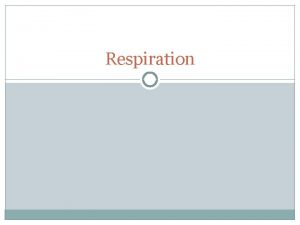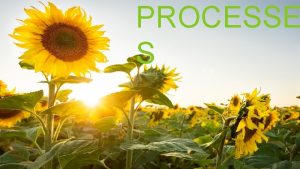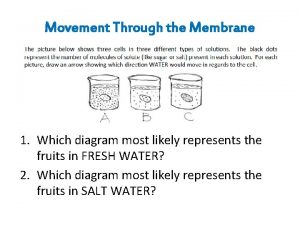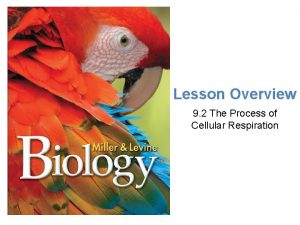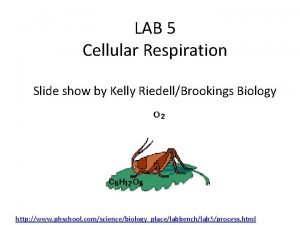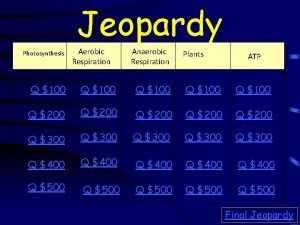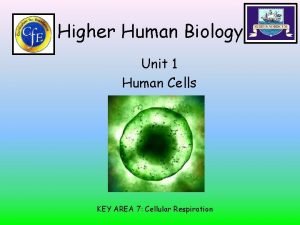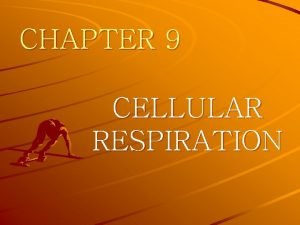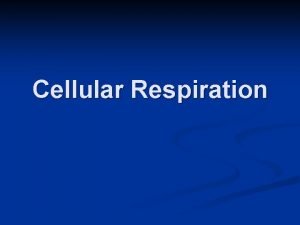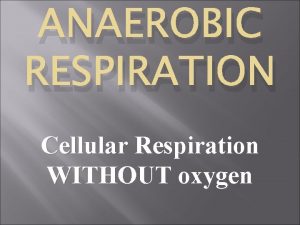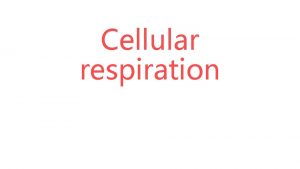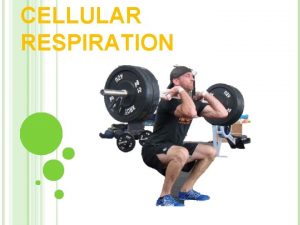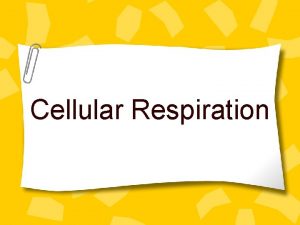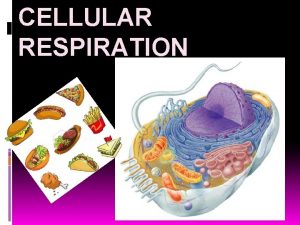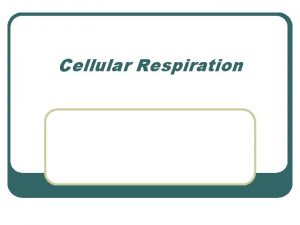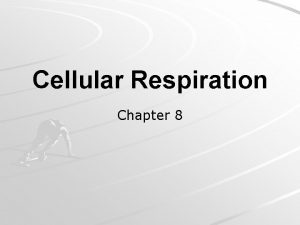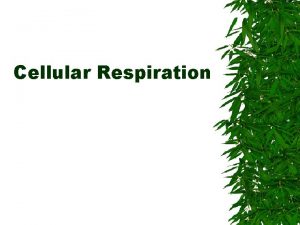Lesson Overview Cellular Respiration An Overview Lesson Overview




















- Slides: 20

Lesson Overview Cellular Respiration: An Overview Lesson Overview 9. 1 Cellular Respiration: An Overview

Lesson Overview Cellular Respiration: An Overview THINK ABOUT IT Breakdown these To make this How does this

Lesson Overview Cellular Respiration: An Overview Chemical Energy and Food molecules contain chemical energy that is released when its chemical bonds are broken. Energy stored in food is expressed in units of calories. A Calorie is the amount of energy needed to raise the temperature of 1 gram of water by 1 degree Celsius. 1000 calories = 1 kilocalorie, or Calorie.

Lesson Overview Cellular Respiration: An Overview of Cellular Respiration If oxygen is available, organisms can obtain energy from food by a process called cellular respiration. The summary of cellular respiration is presented below. In symbols: 6 O 2 + C 6 H 12 O 6 6 CO 2 + 6 H 2 O + Energy In words: Oxygen + Glucose Carbon dioxide + Water + Energy

Lesson Overview Cellular Respiration: An Overview Stages of Cellular Respiration The three main stages of cellular respiration are glycolysis, the Krebs cycle, and the electron transport chain.

Lesson Overview Cellular Respiration: An Overview Stages of Cellular Respiration Glycolysis produces only a small amount of energy. Most of glucose’s energy (90%) remains locked in the chemical bonds of pyruvic acid at the end of glycolysis.

Lesson Overview Cellular Respiration: An Overview Stages of Cellular Respiration During the Krebs cycle, a little more energy is generated from pyruvic acid.

Lesson Overview Cellular Respiration: An Overview Stages of Cellular Respiration The electron transport chain produces the bulk of the energy in cellular respiration by using oxygen, a powerful electron acceptor.

Lesson Overview Cellular Respiration: An Overview Electron Transport Chain Song Electron pair on NADH, Looking for a place to go -You could jump onto pyruvate, But if you want to reach a lower energy state, Why don't you come on down the electron transport chain And take a downhill ride on this one-way train? Oh, won't you come on down the electron transport chain? It exploits delta G to make ATP. Electron pair on FADH 2 -The Krebs cycle's done with you. Though the matrix is your current home, You could be transferred to ubiquinone, And you could come on down the electron transport chain. The loss of one cytochrome is another's gain, So won't you come on down the electron transport chain? It exploits delta G to make ATP. You can't just hold on to the same old thing; Why should you hold on to that nicotinamide ring, When you could come on down the electron transport chain, And take a downhill ride on this one-way train? Oh, won't you come down the electron transport chain? It exploits delta G to make ATP.

Lesson Overview Cellular Respiration: An Overview Oxygen and Energy Pathways of cellular respiration that require oxygen are called aerobic. The Krebs cycle and electron transport chain are both aerobic processes. Both processes take place inside the mitochondria.

Lesson Overview Cellular Respiration: An Overview Oxygen and Energy Gylcolysis is an anaerobic process. It does not directly require oxygen, nor does it rely on an oxygen-requiring process to run. However, it is still considered part of cellular respiration. Glycolysis takes place in the cytoplasm of a cell.

Lesson Overview Cellular Respiration: An Overview Comparing Photosynthesis and Cellular Respiration

Lesson Overview Cellular Respiration: An Overview Lesson Overview 9. 3 Fermentation

Lesson Overview Cellular Respiration: An Overview Fermentation is a process by which energy can be released from food molecules in the absence of oxygen. Fermentation occurs in the cytoplasm of cells.

Lesson Overview Cellular Respiration: An Overview Alcoholic Fermentation Yeast and a few other microorganisms use alcoholic fermentation that produces ethyl alcohol and carbon dioxide. Chemical Equation: Pyruvic acid + NADH Alcohol + CO 2 + NAD+

Lesson Overview Cellular Respiration: An Overview Lactic Acid Fermentation Most organisms, including humans, carry out fermentation using a chemical reaction that converts pyruvic acid to lactic acid. Chemical equation: Pyruvic acid + NADH Lactic acid + NAD+

Lesson Overview Cellular Respiration: An Overview Energy and Exercise How does the body produce ATP during different stages of exercise?

Lesson Overview Cellular Respiration: An Overview Quick Energy Cells normally contain small amounts of ATP produced during cellular respiration, enough for a few seconds of intense activity. Lactic acid fermentation can supply enough ATP to last about 90 seconds. However, extra oxygen is required to get rid of the lactic acid produced. Following intense exercise, a person will huff and puff for several minutes in order to pay back the built-up “oxygen debt” and clear the lactic acid from the body.

Lesson Overview Cellular Respiration: An Overview Long-Term Energy For intense exercise lasting longer than 90 seconds, cellular respiration is required to continue production of ATP. Cellular respiration releases energy more slowly than fermentation does. The body stores energy in the form of the carbohydrate glycogen. These glycogen stores are enough to last for 15 to 20 minutes of activity. After that, the body begins to break down other stored molecules, including fats, for energy.

Lesson Overview Cellular Respiration: An Overview Organisms get the energy they need from food. A calorie is the amount of energy needed to raise the temperature of 1 gram of water 1 degree Celsius. Our familiar Calorie is actually a kilocalorie (1000 calories) Generally 1 gram of carbohydrates and protein store 4 Calories, while lipids (fats) store 9 Calories. Food is not broken down into energy until it is needed to make ATP. Cellular respiration is the process that releases energy form food in the presence of oxygen. Overall respiration - sugars + oxygen carbon dioxide + water. (C 6 H 12 O 6 + 6 O 2 6 CO 2 + 6 H 2 O Cellular respiration involves a series of controlled reactions that slowly release the energy stored in food. Three steps of respiration, glycolysis, the Krebs cycle and electron transport chain. Glycolysis only releases 10% of energy and makes pyruvic acid. Pyruvic acid is then used in the Krebs cycle and preps the final stage the electron transport chain where most energy is made because of oxygen as the final electron acceptor.
 Overview of cellular respiration
Overview of cellular respiration Respiration overview
Respiration overview Cellular respiration
Cellular respiration Overview of cellular respiration
Overview of cellular respiration Redox reaction in cellular respiration
Redox reaction in cellular respiration What is the correct equation for cellular respiration?
What is the correct equation for cellular respiration? Cellular respiration steps
Cellular respiration steps Types of respiration
Types of respiration Fermentation
Fermentation Why is cellular respiration important
Why is cellular respiration important Complementary processes
Complementary processes What plant need for photosynthesis
What plant need for photosynthesis How are internal and external respiration alike
How are internal and external respiration alike Photosynthesis ewuation
Photosynthesis ewuation Starting materials for cellular respiration
Starting materials for cellular respiration Electron carriers in cellular respiration
Electron carriers in cellular respiration Lab bench cellular respiration
Lab bench cellular respiration What is the word equation for cellular respiration
What is the word equation for cellular respiration Higher human biology cellular respiration
Higher human biology cellular respiration Chemical formula for cellular respiration
Chemical formula for cellular respiration What are the reactants and products of photosynthesis
What are the reactants and products of photosynthesis







